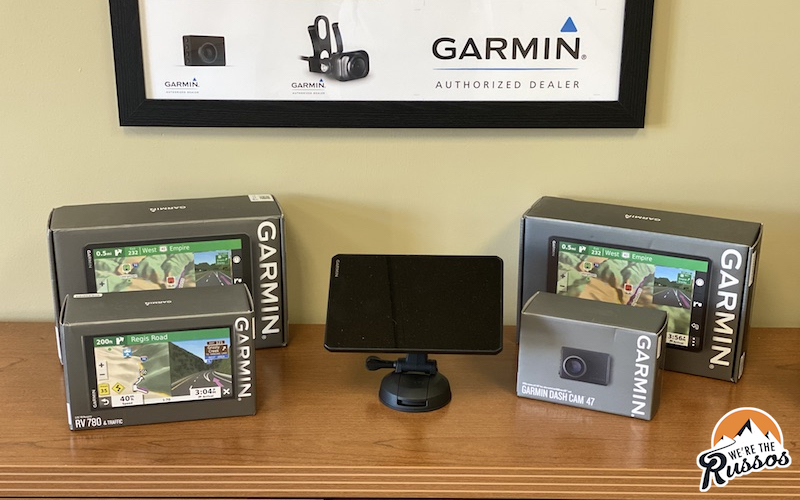This post may contain affiliate links.
In a world where just about everyone has a smart phone with mapping software in their pocket, it may sound crazy to say that a Garmin RV GPS is an essential gadget for RV travel. But we’re saying it anyway because we can’t image driving a large motorhome without an RV specific GPS.
This post will cover the reasons to consider an RV specific GPS, the latest GPS for RVs and our Garmin RV GPS review.
Why You Need a Garmin RV GPS in 2024

If you’re thinking, “Why would I spend that much money on something I can get on my phone for free?”, you’re not alone. We too were hesitant to make this kind of investment when there are so many (free) mobile apps on the market that seem to perform the same function. GPS units seemed like dinosaurs, something that belonged in the early 2000s along with MapQuest.
And yet. After just a few months of navigating with the Garmin RV GPS in our first motorhome, we couldn’t imagine life without it.
Reasons to Have a Garmin RV GPS
Customized Routing
Even the smallest motorhomes are larger than your average SUV. An RV GPS considers the size of your large vehicle when calculating the optimal route. If you’ve ever approached a low bridge and thought too late, ‘I wonder exactly how tall my rig is,’ then you understand how crucial the dimensions of your RV are for routing.
The Garmin RV GPS has a profile section where you can input the width, height and length of your RV. The RV GPS we used had two profile options so we set on up for our Class A motorhome, and one for our Jeep Wrangler tow vehicle.
When we drove the motorhome, we would select the RV profile. This allowed the GPS to customize the route. The mapping included relevant restrictions, such as low overhangs and bridges, as well as weight-restricted roads and steep grades on roads and highways. This helped ensure that we didn’t end up on a road with low clearance or a weight restriction.
Offline Capability
Unlike Google Maps and other mapping software on our phones, the GPS doesn’t need connectivity to work. The device will work as long as it can connect to a satellite. We never ran into a situation where the Garmin RV GPS could not connect. This is incredibly useful when you’re on Forest Service or BLM land looking for a boondocking spot, where service can be spotty or nonexistent.
Offline capability also means the GPS does not eat up valuable gigabytes of data. If you’re traveling a lot, you may run into instances where you exceed your mobile data cap and are charged extra.
Large Display and Intuitive Alerts
The large 7, 8 and 10 inch display sizes of the Garmin RV GPS makes it easier to read than a cell phone screen. Yellow bars and audio notifications alert us if the road conditions are changing (sharp curve, steep grade, school zone, speed limit change, etc.). The turn-by-turn directions are clear and easy to follow. The RV GPS will also provide clear instructions on when to change lanes so that you’re in the right place for a highway division or interchange.
Steer Clear of Tolls
The RV GPS allows you to preview possible routes before a trip. If you want to avoid tolls like we did, you can make that decision in advance. The routes will show estimate time of arrival and total mileage. These estimates are specific to an RV and not to a car, which is handy when it comes to estimating arrival time. Traditional mapping software assumes that you can always go at least the speed limit, and this isn’t always the case for RVs.
See What’s Coming
An RV GPS will also show stops that RVers care about: restaurants, gas stations, banks, rest stops and RV services. If you are looking for something specific such as a Costco gas station, you can use the search feature.
Latest Garmin RV GPS Models
As of writing this post, the Garmin RV 795, the Garmin RV 895, and the Garmin RV 1095 models are the latest and greatest RV GPS units. The main difference between the three is the 795 has a 7″ screen, the 895 has an 8″ screen and the 1095 has a 10″ screen. The only other difference between the three is that the 795 comes with a suction cup mount and 895 and 1095 come with a quick-detach magnetic suction cup mount.
Garmin RV GPS Features
- High-resolution edge-to-edge touch display in 7, 8 and 10 inch screens
- Custom routing for the size and weight of your RV
- Road warnings
- Directory of RV parks and services, TripAdvisor® traveler ratings plus integrated content from Ultimate Public Campgrounds, KOA®, iOverlander™, PlanRV™ TripAdvisor®, Foursquare® and more
- Voice control, hands-free calling (phone integration) and built-in WiFi for easy updating without a computer
- Preloaded street maps for North America with coverage of the U.S., Mexico, Canada, Puerto Rico, U.S. Virgin Islands, Cayman Islands and Bahamas
Garmin RV GPS Includes:
- Vehicle suction cup mount (795) / Quick-Detach suction cup mount (895/1095)
- Traffic receiver/vehicle power cable
- USB cable
- Documentation
Price of Garmin RV 795 on Amazon
Garmin Overlander
Last, but not least, there’s the Garmin Overlander, the most robust of the lineup.
In a word, the Overlander is cool. The vast majority of RVers won’t need an RV GPS unit this robust; as the name implies, it’s built for four-wheelers who venture into some tough territory.
Garmin Overlander Features:
- On- and off-road navigation
- Topographic maps for North and South America
- Spoken directions with street maps for North and South America
- Share your travel plans through Garmin Explore
- Powered magnet mount and RAM ball mount
- 64 GB of built-in storage
- Compatible with HuntView maps (sold separately)
- Military standard 810 for thermal and shock resistance
- IP5X dust rating
- Pre-loaded data from iOverlander, including public land boundaries
- Integrated pitch and roll angles to assist on tricky terrain
Garmin RV GPS Review
The RV GPS unit we owned was the Garmin RV 760LMT. It is no longer in production and has been replaced with the newer Garmin GPS models listed above. Watch the video to learn more about why we thought the Garmin was the Best RV GPS.
Shortcomings of RV GPS
An RV GPS review would be incomplete without an acknowledgment of its shortcomings. GPS devices aren’t perfect and here are some of the problems we had with ours.
Outdated Information or RV Access Unknown
The biggest struggle with RV GPS is that it needs to be manually updated. Unlike Google Maps or other app software that updates constantly in the cloud, your RV GPS software has been downloaded to your device. It’s only ever as accurate as the last update.
We’ve seen the speed limit off by 5 to 10 miles an hour, or RV access for a main road is listed as unknown. We learned not to rely entirely on the GPS and to keep aware of signage. When RV access is unknown, the GPS will route to a road where access is known. This has led us to a few out-of-the-way and sketchy routes. This wasn’t the norm but it did happen. That said, we’ve had apps like Google Maps route us down small country or dirt roads where a large RV would never fit in an effort to provide the “quickest” route. Most recently, we had Google Maps route us along a road where we had to cross a narrow, one-lane bridge. The weight limit for this bridge is 3 tons which means even the smallest RVs would be overweight for the bridge (and even some full-size pick-ups). In order to get to the other side, we had to detour back and find another route manually since Google would not provide an alternate.
As Garmin stated on their website “Always defer to all posted road signs and road conditions when making driving decisions.”
Summary
Overall, the Garmin RV GPS is a great tool and one of the best RV GPS out there. If you are in the market for a Garmin RV GPS, considering making a purchase through our Amazon affiliate link. There is no additional fee for the buyer and in return we receive a small percentage of the sale. Thanks for your support! We really appreciate it.

Both the Garmin 770 and 780 GPS navigators for trucks, RVs and other large vehicles feature the company’s trademark Active Lane Guidance. Unlike other cheap GPS devices where you have to pay a certain price if you want to get map updates, you only have to pay for the GPS device and with Garmin you have access to unlimited map and traffic updates.
Garmin has always been a leader in GPS technology, and I would love to have a Garmin for my RV too. But I am wondering between the Garmi 890 and the 1090. Which should I choose?
Hi Kenneth – the big difference between the two units is the screen size. The 890 has a 8″ screen and the 1090 has an 10″ screen. If you’re going to mount the device further away, I would suggest the larger screen. TechnoRV does a great job with information and guides for the various GPS units along with great customer service. I’d suggest checking their website and if you end up buying from them, they’ll email you content to help with using the device.
Thanks for the article. I’m planning to install a satellite navigator in my RV. I’m choosing between the Garmin RV 785 and 890. Which is better for my RV?
Hi Dalton – the big difference between the two units is the screen size. The 780 has a 6.95″ screen and the 890 has an 8″ screen. If you’re going to mount the device further away, I would suggest the larger screen. TechnoRV does a great job with information and guides for the various GPS units along with great customer service. I’d suggest checking their website and if you end up buying from them, they’ll email you content to help with using the device.
Garmin is a global leader in navigation system manufacturing, offering mapping and GPS systems for the maritime, aviation, automobile, and fitness industries.
I am looking at the 780; the specs indicate it has info on US parks, but I am wondering about Canadian parks etc. We are hoping to go across Canada next year (COVID permitting) and while this looks like a very good GPS, if it only contains US specific data, I am not sure it’s worth it.
Thanks for your information. But I want to know which is the better GPS for your RV between garmin RV 760 vs 770. I also want to a new one. Can you give some advices? Thanks again!
We haven’t used the 770 so I can’t tell you. My suggestion would be to look at the features and see if you prefer one over the other.
Oh! Thank you. I have read a article and I have known garmin Rv 770 is better than. Someone can refer in here: https://vogeltalksrving.com/garmin-rv-760-vs-770/#more-252. I think it useful.
Can the Garmin RV gps be used as a portable gps for hiking?
Thanks.
Good question. We’ve only used it in our vehicles but you can certainly take it along. Not sure how long the battery will last though.